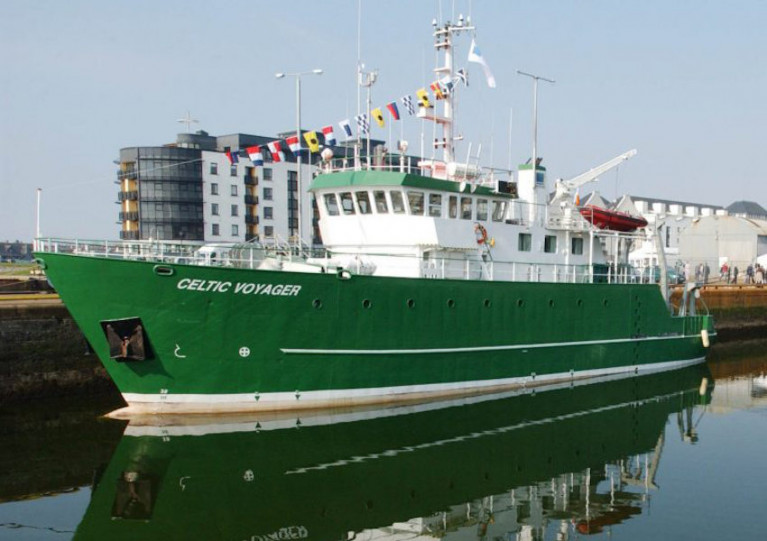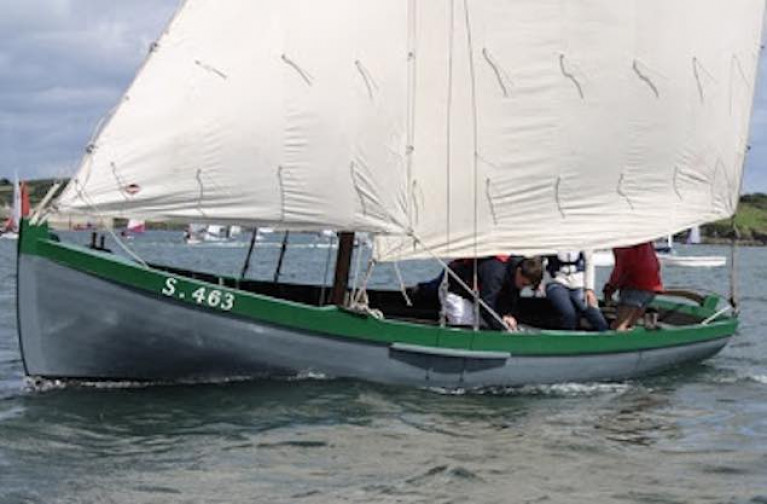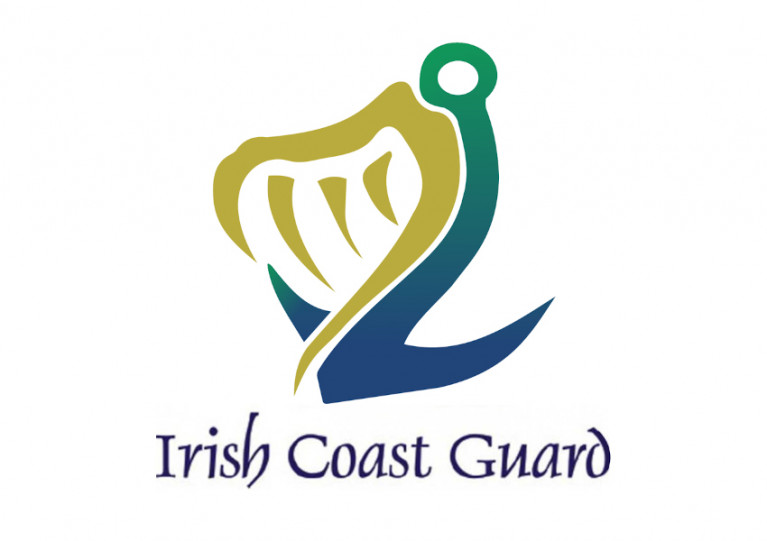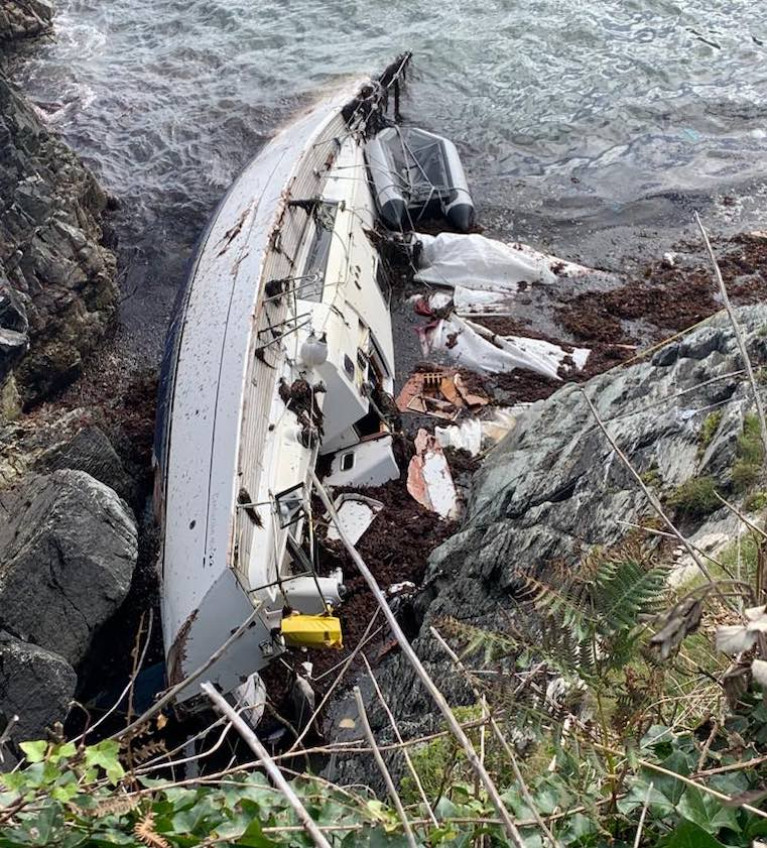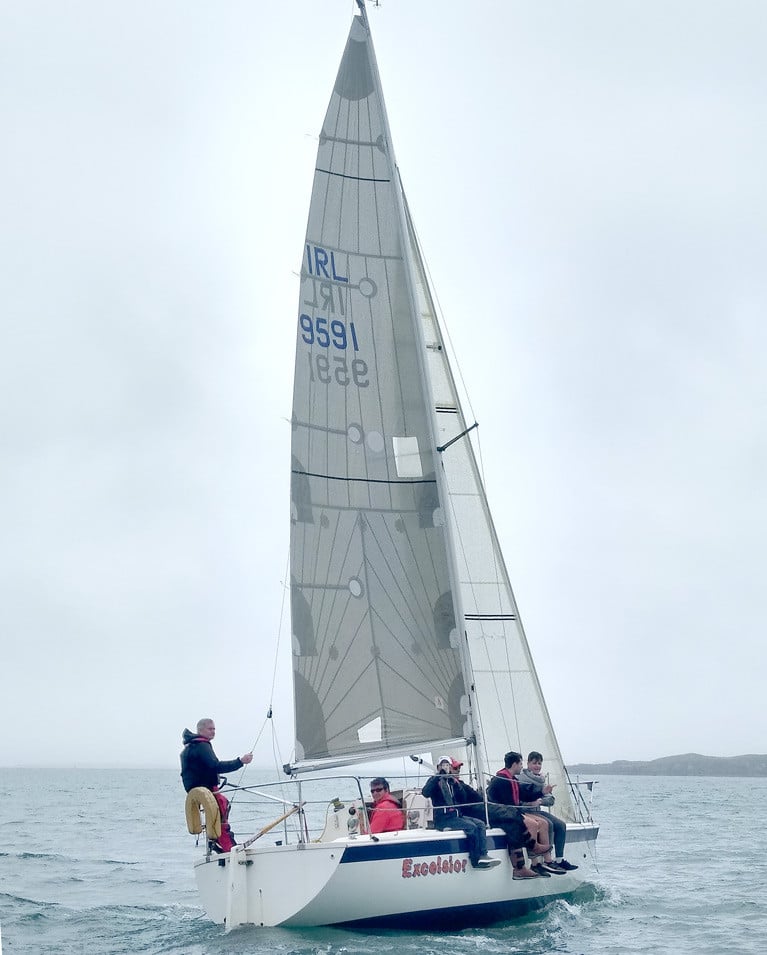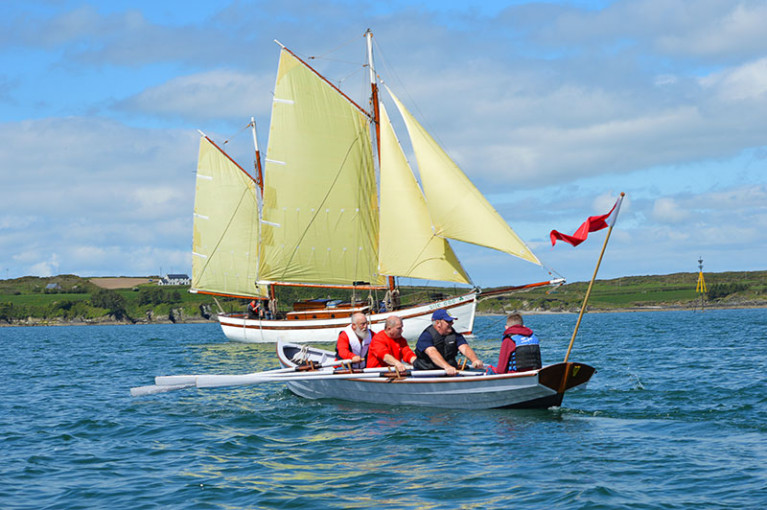Displaying items by tag: west cork
Gas Field Decommissioning Works off West Cork This Week
Seabed survey operations in the Kinsale, Greensands, Ballycotton and Seven Heads gas fields off West Cork are set to commence from tomorrow, Sunday 6 December.
PSE Kinsale Energy will undertake the decommissioning works on and around the relevant subsea infrastructure over the next week, weather permitting, from the RV Celtic Voyager (Callsign EIQN).
The surveys will extend over an area of 2.5km radius (including the area required by the vessel to turn) from each well head, towing a submerged cable of up to 500m behind the vessel.
Full coordinates for these survey operations and a map of the area are included in Marine Notice No 56 of 2020, a PDF of which can be downloaded below.
West Cork Traditional Boat Sets the Style on America's Great Lakes
You can take the boy out of West Cork, but you can't take West Cork - and its boats and sailing - out of the boy. That's especially so if he's one of the O'Keeffes, whose great names in sailing - such as Paddy O'Keeffe of Bantry and Maurice O'Keeffe of Schull - live on afloat through present generations, and in the restored and much-loved classics which they sailed in their day.
An intriguing example of the "Reach of the O'Keeffes" is Don O'Keeffe of the Schull branch. He may have fetched up in Wisconsin in the American Midwest, but by so doing and making a successful career there since 1987 in motor-yacht design, he reminds us that not only are the Great Lakes much more extensive than many of the salty seas that most of the rest of us so proudly sail, but his home port of Manitowoc has also been the setting – since 1968 – of the Wisconsin Maritime Museum, an institution which has steadily developed and expanded to put anything comparable in Ireland very much in the shade.
The quality of the WMM's dynamic interaction with the local community and the world beyond is well illustrated in this museum-produced video of a project that Don O'Keeffe recently brought to completion:
It tells us a lot, and very eloquently too, for Don has a lovely way with words. But for those who seek even more background, his 25ft 6ins Heir Island Lobster Boat Fiona is based on the lines – taken off by the Traditional Boats of Ireland Project – of the 1893-built Hanorah, which was re-built in 2003 in Oldcourt as part of a course run by owner Nigel Towse of Sherkin Island, and master boatbuilder Liam Hegarty.
 The traditional lines of Hanorah have been replicated in Don O'Keeffe's new boat Fiona in Wisconsin. Plans: Traditional Boats of Ireland
The traditional lines of Hanorah have been replicated in Don O'Keeffe's new boat Fiona in Wisconsin. Plans: Traditional Boats of Ireland
 Hanorah (left) and new-build sister-ship Saoirse Muirreann (Cormac Levis) in perfect summer sailing conditions off Sherkin Island. Photo: Robby Murphy
Hanorah (left) and new-build sister-ship Saoirse Muirreann (Cormac Levis) in perfect summer sailing conditions off Sherkin Island. Photo: Robby Murphy
In recent years we've had two links to Don O'Keeffe, as this most recent Wisconsin project came to us through Simon O'Keeffe of Schull, Don's nephew, who currently has a project under way with Tiernan Roe of Ballydehob to restore the famous gaff cutter Lady Min, which Simon's great grandfather Maurice O'Keeffe designed and built at Schull in 1902.
 The Lady Min – currently under restoration with Tiernan Roe of Ballydehob – was designed and built by Maurice O'Keeffe of Schull in 1902.
The Lady Min – currently under restoration with Tiernan Roe of Ballydehob – was designed and built by Maurice O'Keeffe of Schull in 1902.
But while Maurice O'Keeffe is now best known for his personal creation of the Lady Min 118 years ago, across the hills in Bantry Paddy O'Keeffe was linked to several notable boats, most notably the Albert Strange-designed yawl Sheila II which later was sailed to New Zealand in the 1950s, the handsome Robert Clark-designed 16-tonner John Dory, and designer-builder John B Kearney's own pet boat, the 1925-built 38ft yawl Mavis, which went to America in 1956.
We have of course been following the saga of the restoration of Mavis in Camden, Maine by Ron Hawkins. But while she finally sailed again in September of this year, when she was launched for the first time in her restored form back in 2015, as Ron Hawkins shepherded her down the harbour with a little outboard-driven tender alongside, at the helm of Mavis was Don O'Keeffe no less, keeping in touch with the boats of his youth and the special sailing to be found in West Cork.
 The newly-restored John B Kearney 1925 yawl Mavis – owned for some years by Paddy O'Keeffe of Bantry – is shepherd to her mooring in Camden, Maine by restorer Ron Hawkins, with Don O'Keeffe on the tiller.
The newly-restored John B Kearney 1925 yawl Mavis – owned for some years by Paddy O'Keeffe of Bantry – is shepherd to her mooring in Camden, Maine by restorer Ron Hawkins, with Don O'Keeffe on the tiller.
More Details Emerge Over Emergency Beacon Incident Off West Cork Last Month
The Irish Coast Guard has revealed further details over an incident involving the activation of an emergency positioning beacon off West Cork last month.
As previously reported on Afloat.ie, Baltimore RNLI was called out to search or the EPIRB which activated two nautical miles west of the Calf Islands on the afternoon of Wednesday 19 August.
Despite an extensive operation which also involved Schull Coast Guard, a coastguard helicopter and the Naval Service vessel LÉ Samuel Beckett, nothing was found and the search was stood down by early evening.
‘…it is highly unusual to have detections of the type that was encountered on 19 August’
In response to further enquiries from Afloat.ie, the Irish Coast Guard said the EPIRB in question, which was last detected at Coosnagulling on the southwest of Long Island, “did not appear to be fully functional and the homing signal was not active.
“It was not registered in Ireland and registration details were not available. It was not of Irish origin.”
Confirming that the search was terminated with “no further action being deemed necessary”, the IRCG added: “Accidental activations of EPIRBs are not unusual but it is highly unusual to have detections of the type that was encountered on 19 August.
“Every effort was made to locate the device both inland and on the coast but as outlined above, the search proved to be unsuccessful given the operational gaps in the information that was available.”
Yachts at Crookhaven, West Cork Damaged in Storm Francis
The West Cork harbour of Crookhaven took a hammering earlier this week in Storm Francis with at least one sailing boat lost from its mooring on Tuesday.
Footage online shows the village pontoon swaying in the Force 11 gusts (see vid via Facebook below) as Cork County battled with a Status Yellow Weather Alert.
As Afloat previously reported, Baltimore's all-weather lifeboat was called to two yachts in difficulty in Crookhaven. The two vessels, one with four onboard and the other with two, were dragging their moorings in the strong Force 9 winds, gusting up to Force 11, and rough sea conditions with a five-metre swell.
It's not the only West Cork Harbour affected either in this month's storms. More boats were damaged at nearby Baltimore.
In a tough month for Cork sailing, as Tom MacSweeney reports, the new Cove Sailing Club marina in Cork Harbour was damaged in the earlier Storm Ellen.
€1m for Castle Island in Roaringwater Bay, West Cork
Historial Castle Island in Roaringwater Bay off the coast of Schull, West Cork is on the market for offers in excess of €1m.
The island is located immediately east of the entrance to Schull Harbour and south-west of Horse Island. It is readily accessed from either Schull Harbour or Rossbrin Cove.
It is one of very few privately owned islands in the area.
The island, which extends to approximately 123.85 acres or c. 50.12 hectares, was home to a small community of approximately fifteen families who were last resident on the Island up to the year 1870.
 A substantial Pier and Slipway that offers very considerable shelter and access to the island in most weather conditions at all tidal stages
A substantial Pier and Slipway that offers very considerable shelter and access to the island in most weather conditions at all tidal stages
According to the auctioneer Dominic Daly, the ruins of the original three clusters of houses which made up the community are situated in three distinct locations the first at the pier where the original O’Mahony Castle stands and the other two at each end of the island. Lazy beds can be detected near one of the clusters of houses which look out across Roaringwater Bay and onward to Fastnet lighthouse a naturally beautiful landscape. Currently, the island is in use for agricultural purposes. Tillage was undertaken there in the past. It is now used for grazing.
There is a substantial Pier and Slipway that offers very considerable shelter and access to the island in most weather conditions at all tidal stages. A number of adjoining islands in Roaringwater Bay are inhabited – some with small communities (Long Island, Heir Island, Sherkin Island, Cape Clear Island) and others by single families (West Skeam Island, Horse Island).
 Castle Island, Roaringwater Bay
Castle Island, Roaringwater Bay
Castle Island is home to one of a number of ruined O’Mahony Castles – one of a string along the coastline, all within sight of each other and sited strategically to control the waters of Roaringwater Bay and their abundant resources. The O’Mahony’s became extremely wealthy in their day, charging for fishing and fish processing facilities and for supplies and fresh water. They also formed strong alliances with the Spanish and French fishing fleet and any visitors who worked these waters an alliance that came to the attention of the English crown, which lead to the O’Mahony’s demise in the area.
It is a great opportunity for anyone interested in all water sports particularly sailing and fishing. It also benefits from the warm Gulf Stream and mild south westerly winds. The island can offer total solitude with substantial scope to develop it’s considerable amenities. There are extensive amenities in the area with multiple Harbours in Schull and Baltimore and also good shelter in Rossbin & Crookhaven as well as Cape Clear. In the far distance, the Fastnet Rock Lighthouse can be seen.
West Cork is a predominantly tourist area. It has rugged peninsulas, sandy beaches and bustling market towns. Future use of the island could be for private occupancy or tourism-related development or outdoor pursuits and/or agricultural use.
More details from auctioneer Dominic Daly here
The first race of the West Cork sailing season took place on Saturday in murky conditions with intermittent foggy spells and light rain making it a tough return to sailing for the Schull harbour sailing fleet.
The seven yachts had a tough double beat up Long Island Sound in a freshening southwest wind. In a time of necessary adherence to social distancing, the club ran a ferry service limiting the transfer of each crew as a single pod.
 The seven boat fleet had tough windward legs up Long Island Sound
The seven boat fleet had tough windward legs up Long Island Sound
The traditional apres sail prize presentation is currently cancelled with Tony O Brien's Excelsior on his first outing with the club receiving his victory news online.
 Preparing to go afloat at Schull Harbour for the first race of the 2020 season
Preparing to go afloat at Schull Harbour for the first race of the 2020 season
In locked-down Baltimore in West Cork, the word is that in current circumstances, the most exciting thing that happens during the day is when a dog walks past, taking its sniff-busy morning walk up the empty street. Everybody goes to their window to watch this major event until the canine inspector has disappeared from view, and then they return to the task in which they’d been engrossed.
Those who are making some semblance of working from home for the first time are learning that for most folk, it ceases to be home once you have to do some supposedly income-generating task within its walls. Those social commentators who are predicting that our ways of working will see a marked change once the current situation has got back to something approaching normality seem to be unaware of this inescapable fact. Completely separate work-places are necessary for most people to work. That’s all there is to it.
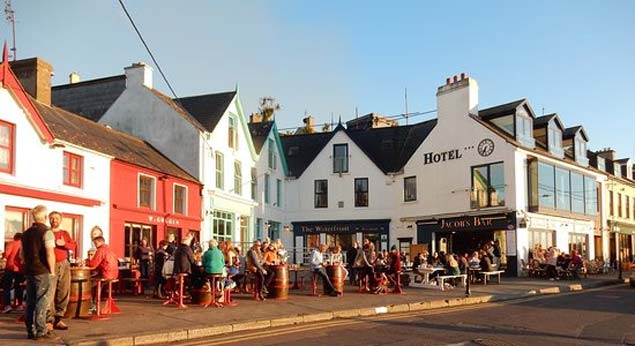 Baltimore in more normal times on a sunny summer evening. Currently, the height of the locked-in day’s excitement is when a solitary dog walks up the road
Baltimore in more normal times on a sunny summer evening. Currently, the height of the locked-in day’s excitement is when a solitary dog walks up the road
For sure, there are those of us who have always worked from home, but as one of them, I can assure you that it’s not a way of life for everyone. And the basic reason we earn a meagre crust in this way is that we probably lack the social skills to function in an interpersonal situation at some sort of work-station with anyone within anything remotely approaching today’s mandatory two-metre social distancing.
"the most exciting thing that happens during the day is when a dog walks past"
In fact, we don’t want anyone in the same room, and one other inhabitant within the same building is all that is required to hope that from time to time, a cup of coffee or tea might appear, or a clever light lunch gets effortlessly rustled together with a chance that it might be enjoyed in the suntrap down the garden.
That said, we’re lost in admiration for those techno-whizzes who have invented ways of making the whole business of being house-bound more entertaining, and it’s said that in Baltimore they’ve now got an online sweepstake running as to when certain dogs will take their daily dander up the street. I’ve no idea if it’s true that some rogue elements have taken to releasing cats into the empty streetscape in order to upset some gamblers’ carefully made observations and closely-calculated predictions. But in times like this, all’s fair for a spot of entertainment and distraction.
Because with Easter plumb in the middle of April where it should be on a permanent basis, and with good weather a real possibility, people are going up the walls in holiday sailing places which would normally be springing to fresh life this Friday. So just to sharpen the exquisite torture, at the end of this piece there’s a link to a Sailing on Saturday blog from 2014 which seemed to succeed in capturing the flavour of Baltimore on a sunny sailing weekend, for it received a gratifying global response.
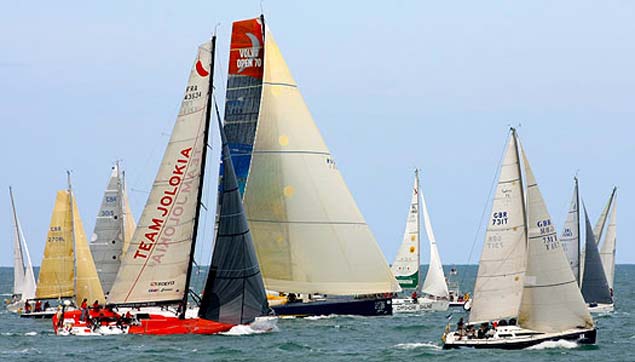 Typical start for the biennial Round Ireland Race from Wicklow. With nearly everything else announcing early cancellations for major events because of COVID-19, Wicklow SC are quite right to stay on track until the end of April, for it’s not as if anyone else will have an alternative programme in mind for June 20th
Typical start for the biennial Round Ireland Race from Wicklow. With nearly everything else announcing early cancellations for major events because of COVID-19, Wicklow SC are quite right to stay on track until the end of April, for it’s not as if anyone else will have an alternative programme in mind for June 20th
But before we go to it, let me just say that I think Wicklow Sailing Club is absolutely right in postponing until the end of April any decision on cancelling their 20th June Round Ireland Race. With every other major event falling over itself to cancel early, what alternative programme would potential Round Ireland Racers have in mind?
But enough of that – here’s Baltimore and West Cork in the summer of 2014, and though some things have changed, others are eternal in their charm.
Optimist Spring Training Dates Set For 2020 In Baltimore
16-21 February are the dates to save for Optimist Spring Training at Baltimore Sailing Club in West Cork.
This year the class has teamed up with freelance dinghy performance coach Thomas Chaix to work collaboratively on training sessions to kick off the season — riding high on the international success of Oppy helms like Rocco Wright.
And at the end of the week the assembled Optimist sailors have their pre-trials regatta.
On the social side, IODAI has organised a movie night at Casey’s Hotel and an end-of-week disco with the opportunity for parents to relax and meet up for a meal.
Registration for 2020 Spring Training is now available online. For more details contact Mandy at [email protected] see the IODAI website.
Shepperton Lakes in West Cork will now be eco-friendly following the introduction of measures to reduce the carbon footprint of anglers fishing the popular Shepperton (Shreelane) fishery.
Inland Fisheries Ireland (IFI) is introducing regulations which will only permit battery-powered engines on the lake from 1 January 2020.
As part of the eco-friendly measures, Inland Fisheries Ireland is removing its four petrol engines from use at Shepperton, between Leap and Skibbereen.
Anglers can now hire one of the recently refurbished boats and bring their own battery-powered engines.
This follows similar measures introduced at Ballinlough, north of Leap, which has operated successfully for a number of years.
The boat hire at Shepperton Lakes, including a one-day fishing permit for up to two anglers, will cost €30.
‘…a popular winter pike angling destination attracting local and visiting anglers to the area’
Sean Long, director of the South Western River Basin District, said: “This initiative was proposed by the local Inland Fisheries Ireland ‘Green Team’ as a quick and simple measure to reduce carbon emissions.
“We are pleased to offer this green solution to anglers at the lake while also maintaining the permit price once again this year.”
IFI’s Green Team comprises staff in various locations across the country and is part of the organisation’s efforts to refocus its philosophy in line with the critical nature of climate change and the impact it is having on the fisheries resource.
The Green Team works to create solutions which will help achieve an energy reduction target of 33% by 2020 and devise solutions which will support society in reducing its environmental footprint.
Shepperton/Shreelane Lakes in West Cork represent a popular winter pike angling destination attracting local and visiting anglers to the area.
As shore angling is not permitted, anglers are advised to book a boat locally from Mrs E Connolly via telephone 028 33328 in advance to avoid disappointment.
Busy Weekend For West Cork Lifeboats In Baltimore & Courtmacsherry
Following last Thursday’s launch to a sailing dinghy aground on an island near Baltimore Harbour, the local RNLI crew were called out twice on Sunday (22 September), with the first to other boat aground in the harbour.
The inshore lifeboat was on scene in a matter of minutes after they were notified that the 14m sailing boat had run up on rocks at the harbour’s edge.
Volunteer crew set up a tow line to return the vessel to deeper water and, once it was checked over for damage, the lifeboat towed the yacht head to wind to let its crew set their sails.
Baltimore’s inshore lifeboat launched again at 3.36pm to assist a RIB with five people on board which broke down and was at anchor off Castle Point, near Schull Harbour.
However, while en route the lifeboat was stood down after word came through that the RIB’s occupants had managed to get themselves under way.
Elsewhere, in West Cork, Courtmacsherry’s all-weather lifeboat launched on Saturday evening (21 September) as bad weather unfolded to rescue a surfer in difficulty off Inchydoney.
As the lifeboat was speeding across Clonakilty Bay to the reported location, its crew were informed that the surfer had managed to get ashore safe and well.
Deputy launching authority Diarmuid O’Mahony praised those on shore who called for help for their quick alert: “Vital minutes today could have been so important in sea conditions that were very poor.
“I also want to commend all the volunteer crew who responded so quickly in coming to the lifeboat station in the knowledge that they were going to face some mountainous seas and difficult conditions off the coast.”
As previously reported, Crosshaven RNLI also launched yesterday to two sailors whose catamaran dinghy capsized in Cork Harbour yesterday evening.





























